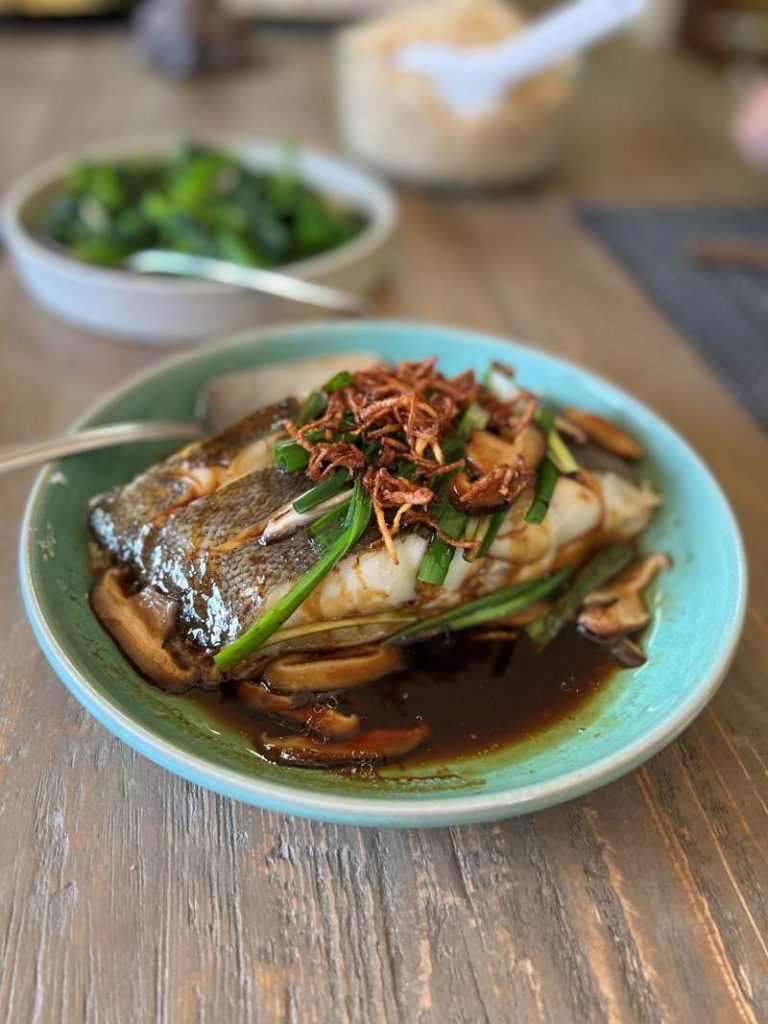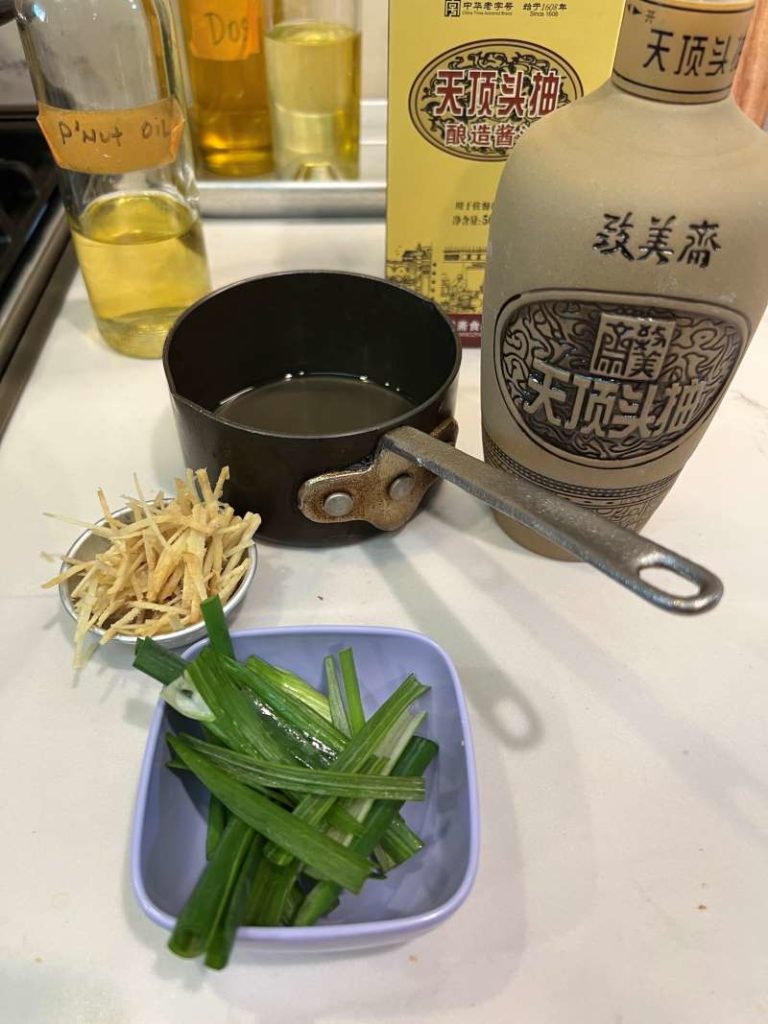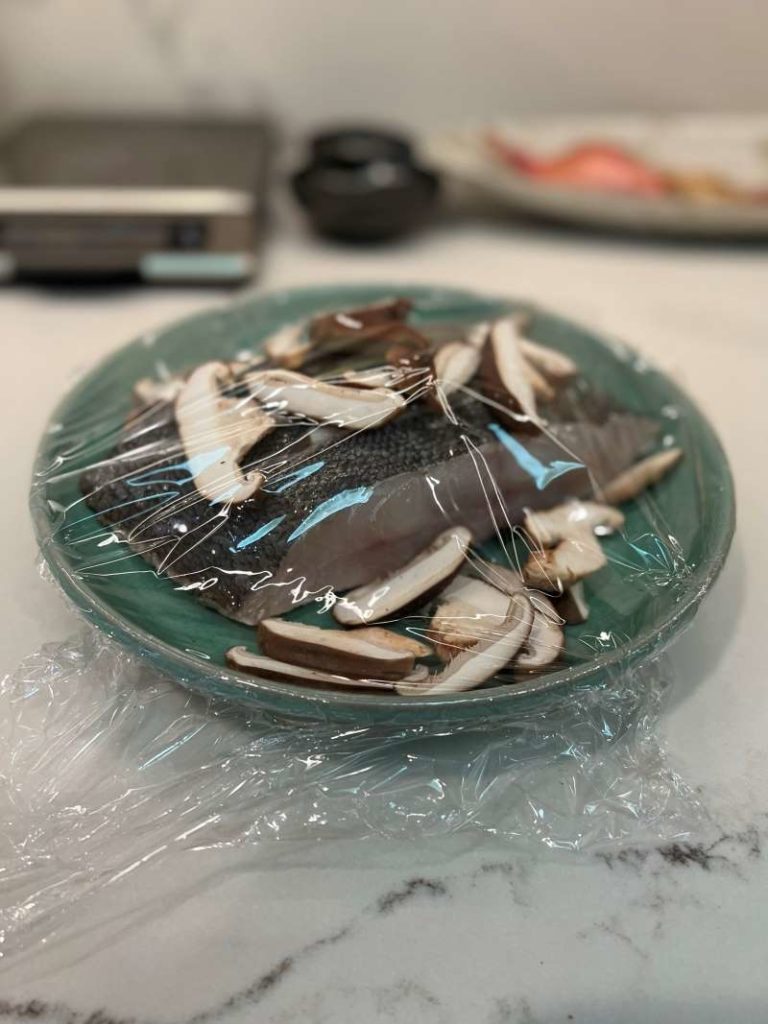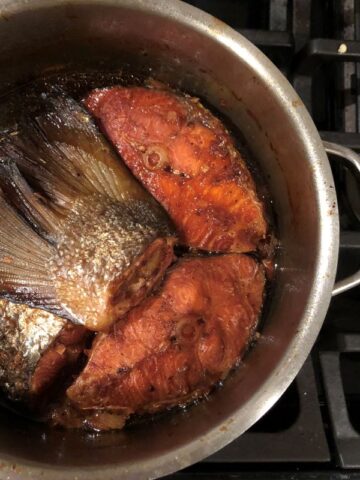
In the early 1990s when I was studying on a fellowship program in Hong Kong, my local host invited me to dinner. I was excited to observe a home cook in action. But much to my surprise when I arrived, Mr. Wong's wife had all the food neatly arranged on plates. She then microwaved everything to cook or reheat. That evening, aside from singing karaoke for the first time, what stood out to me most was the steamed fish. Mrs. Wong bought the flat pompano at the market as a kit, with all the fixings, then transferred the contents onto a plate and zapped it in her nuker. Her meal was easy going.
The other night, I recalled the experience of that Hong Kong meal when I needed a simple quick dinner and had a piece of fish in the fridge waiting to be steamed. Instead of pulling out the Chinese steamer, or turning on the oven to bake the fish in parchment as I suggest in a Vietnamese Food Any Day recipe, I microwaved the fish.
The fried ginger sizzle is a new thing that turned out to imbue the hot oil with mellow ginger flavor while creating a dramatic slightly crisp edible garnish. Here are tips for microwaving steamed fish plus a video and recipe for you to tinker with.
What kind of fish to steam
Steaming a whole fish is grand but you may certainly use fish filet. My local favorite Chinese restaurant steams fish filet and it's great. I like fish on the bone so a fish steak is nice. For this recipe, I purchased a portion of bone-in, skin-on flounder at H-Mart, the Korean equivalent to Ranch 99, which leans toward China and Taiwan. You do not have to shop at an Asian market for the fish. If you're interested in steaming a whole fish, try a trout; it is small, easy to find fresh, and deliciously forgiving. Trout is sustainable and affordable too! Regardless, pick the fish that is freshest. Fresh fish should have a slight sheen on the flesh and skin; any eyeballs should be plump and vivid. Ask the fish mongers for assistance. They know what's freshest. Salmon would be fine here. So would sole or tilapia. People often times spend a lot of money for steamed fish but when I casually cook for myself, I look for the best fish at the moment. Sometimes it's on sale. Sometimes it was frozen and was thawed, though fresh is often best.
What to steam the fish in
Choose a shallow wide bowl because there will be liquid involved. When you steam in a Chinese-style steamer, you're locked into the size of the steamer tray. In the microwave, there's more wiggle room, depending on the size of your microwave and fish. A whole fish can get very large so you may have to use a platter. I've only seen small fish or portions of a large fish microwaved so let's assume that microwaved steamed fish is casual cooking. Keep it easy going.
Ingredients for Basic Steamed Fish
This is all you need: Salt, Shaoxing rice wine or dry sherry, green onion, peeled ginger, soy sauce and oil. Along with the fish, that's it for a simple Chinese-style steamed fish. If you'd like some extra bling, add sliced shiitake mushroom like I do for this steamed flounder. Use a good tasting soy sauce. The one I have here is something new that I'm trying by Jammy Chai. It's fancy, a Chinese "time-honored brand" which signals that it's considered special, of high quality. There is MSG in the thick, umami-intense soy sauce but what you taste is not about MSG. I like it; it's tasty. Jammy Chai is sold online and at Chinese markets too. Look for the box. It's around $20 per bottle. Or, use your favorite soy sauce, especially if you're gluten-free. Jammy Chai contains wheat.

Steamed Fish Basics
I generally approach Asian-style steamed fish this way: If the fish is whole or a large skin-on portion of larger fish, cut 2 or 3 shallow slits on each side. This allows the fish to cook evenly. It's also where you can rub in some salt to season the inner flesh. Regardless of whether you slit the fish or not, rub fine sea salt (or table salt) all over the fish then rinse the fish and pat it dry. This refreshes the fish for a cleaner flavor.
Cut the scallion whites into short lengths then put some on the bottom of the bowl and place the fish on top. This props the fish up so it won't stick later. Tuck some scallion whites into the slits on the top side of the fish (or just scatter them on). If you have mushroom or other ingredients to add, now is the time to do it.
Now, manipulate the situation for the microwave by adding some water. The water helps to mimic steaming in a Chinese-style steamer. Without water, the fish may turn out dry. Loosely cover then microwave. Once cooked (the main recipe below has cooking time estimates), top the fish with the remaining green onion section, heat up the oil to fry the ginger and then when that's done, pour the hot oil over the green onion to sear it. I normally add the ginger before steaming but the fried ginger added crisp, nutty, zippy bling. Afterwards, finish with soy sauce. That's it.

What to cover the fish with?
Some folks swear by plastic shower caps -- the kind that hotels used to provide to guests. The late Chinese-America restaurateur Cecilia Chiang loved to pull out a shower cap for microwaving steamed fish! I don't have one so I use plastic wrap. If you're not into plastic wrap, try wax paper or use a covered microwaveable dish. I've seen microwave specific dishes for steaming fish but have never seen the need to purchase one.
Why microwave steamed fish?
It's easy and fast. However, it is not as succulent as steaming over water. If you're starting out with steaming fish, it's a great way to experiment. If you're busy and need a quick main dish, microwave steamed fish is a clear option. I'm pointing out the pros and cons of this method because there are gains and losses. Steamed fish is a wonderful special occasion dish but sometimes you just want a quickie version. When those times arise, try the microwave method.
A Quickie How-to Video
For a fast 2-minute recap of how this steamed fish went down in my kitchen, watch this video. (If for some reason the video does not play, refresh your browser.)
Many people have microwave ovens but in the modern food writing world, the appliance is rarely spotlighted. Esteemed author and teacher Julie Sahni wrote an award-winning 1990 cookbook titled Moghul Microwave. Additionally, Barbara Kafka penned the Microwave Gourmet in1987. It wasn't until recently that the microwave has had a small resurgence, thanks in part to Dave Chang and Priya Krishna's new cookbook which includes the microwave in its subtitle. Food and Wine recently had a story on microwave cooking and invited me to contribute an eggplant recipe.
The microwave oven is not perfect cooking but it's surely convenient. Three cheers for the microwave!
Microwave Steamed Fish with Ginger Sizzle
Ingredients
- Chubby 1 ½-inch section ginger
- 2 or 3 medium green onions
- 1 handful fresh shiitake other kind of fresh mushroom
- 1 to 1 ¼ pound fish (whole, steaks, bone-in section or filet)
- Fine sea salt
- 1 tablespoon shaoxing rice wine or dry sherry
- 3 tablespoons water
- 3 tablespoons neutral oil, such as canola or peanut
- 1 to 2 tablespoons soy sauce
Instructions
- Cut the vegetables. Peel the ginger, thinly slice, then cut the slices into fine strips. Put the ginger in a small saucepan or butter warmer. Trim the green onions, cut the white sections into 2 inch long pieces and halve them lengthwise. Cut the remaining green parts into thin strips, 2 to 3 inches long. Slice the mushroom into thin pieces, and include the stems pieces.
- Prep the fish. If the fish is uneven in thickness, cut 2 to 3 shallow slits on each side to facilitate even cooking. Make the slits no deeper than ¼ inch. Regardless of the fish you’ve chosen, sprinkle it with salt all over, rub it into any slits that you may have made, then rinse the fish.
- Assemble and steam. Choose a shallow bowl or plate that the fish will fit upon. Put all or most of the green onion whites in the bowl (or plate) then put the fish atop the green onion. If you like, stuff each slit with a piece of green onion white; scatter any leftover on the fish. Pour on the rice wine, then add the mushroom on top. Pour on the water. Loosely cover with plastic wrap and microwave on high for 3 to 5 minutes. Check doneness after 3 minutes by pushing the tip of a knife into the flesh. If there’s no resistance, you’re done. If not, microwave for 30 to 60 seconds longer.
- Fry, sizzle, and serve. Put the remaining green parts of the green onion atop the cooked fish and keep near the stove. Add the oil to the ginger in the saucepan, then heat over medium heat. After sizzling begins, lower the heat slightly and gently fry, picking up and shaking the pan frequently for about 2 minutes, until the ginger looks light and crisp with some browned tips. Turn off the heat and pour the oil and ginger onto the green onion to sear it. Scrape out any lingering ginger to finish crowning the fish. Drizzle on 1 tablespoon soy sauce, taste the pooled sauce in the dish, then add more soy sauce, as needed. Serve immediately.

















